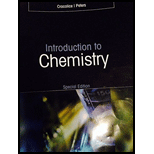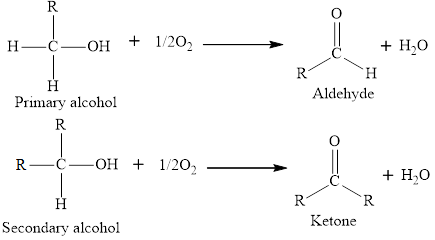
Introduction to Chemistry, Special Edition
6th Edition
ISBN: 9781337035934
Author: Cracolice/Peters
Publisher: Cengage Learning
expand_more
expand_more
format_list_bulleted
Question
Chapter 21, Problem 70E
Interpretation Introduction
Interpretation:
Using the structural formula the reaction for the preparation of butanal by oxidation of alcohol is to be determined.
Concept introduction:
Alcohols are oxidized to produce

Expert Solution & Answer
Want to see the full answer?
Check out a sample textbook solution
Students have asked these similar questions
4. True or false: This skeletal structure represents a saturated fatty acid. Ini to
0
fale) me
OH
faistong st
By malonic or acetylacetic synthesis, synthesize 5-Methyl-2-hexanone (with the formulas of the compounds).
QUESTION: Answer Question 5: 'Calculating standard error of regression' by filling in all the empty green boxes
*The values are all provided in the first photo attached*
Chapter 21 Solutions
Introduction to Chemistry, Special Edition
Ch. 21 - Prob. 1ECh. 21 - Prob. 2ECh. 21 - Prob. 3ECh. 21 - Prob. 4ECh. 21 - Prob. 5ECh. 21 - Prob. 6ECh. 21 - Prob. 7ECh. 21 - Prob. 8ECh. 21 - Prob. 9ECh. 21 - Prob. 10E
Ch. 21 - Prob. 11ECh. 21 - Prob. 12ECh. 21 - Prob. 13ECh. 21 - Prob. 14ECh. 21 - Prob. 15ECh. 21 - Prob. 16ECh. 21 - Prob. 17ECh. 21 - Prob. 18ECh. 21 - Prob. 19ECh. 21 - Prob. 20ECh. 21 - Prob. 21ECh. 21 - Prob. 22ECh. 21 - Is the general formula of a cycloalkanes the same...Ch. 21 - Prob. 24ECh. 21 - Draw the skeleton diagram of cyclopentane.Ch. 21 - Prob. 26ECh. 21 - Prob. 27ECh. 21 - Prob. 28ECh. 21 - Prob. 29ECh. 21 - Prob. 30ECh. 21 - Prob. 31ECh. 21 - Prob. 32ECh. 21 - Prob. 33ECh. 21 - Prob. 34ECh. 21 - Prob. 35ECh. 21 - Prob. 36ECh. 21 - What is the difference in bonding and in the...Ch. 21 - Prob. 38ECh. 21 - Draw the structural formula of trichloroethene, a...Ch. 21 - Prob. 40ECh. 21 - Prob. 41ECh. 21 - Prob. 42ECh. 21 - Prob. 43ECh. 21 - Prob. 44ECh. 21 - Give the IUPAC name of the following molecule:Ch. 21 - Give the IUPAC name of the following molecule:Ch. 21 - Prob. 47ECh. 21 - Prob. 48ECh. 21 - Prob. 49ECh. 21 - Prob. 50ECh. 21 - Prob. 51ECh. 21 - Prob. 52ECh. 21 - Prob. 53ECh. 21 - Prob. 54ECh. 21 - Write an equation for the hydrogenation of...Ch. 21 - Prob. 56ECh. 21 - Prob. 57ECh. 21 - Prob. 58ECh. 21 - Prob. 59ECh. 21 - Explain why the ether with formula C2H6O is very...Ch. 21 - Prob. 61ECh. 21 - Prob. 62ECh. 21 - Prob. 63ECh. 21 - Prob. 64ECh. 21 - Prob. 65ECh. 21 - Prob. 66ECh. 21 - Prob. 67ECh. 21 - Prob. 68ECh. 21 - Prob. 69ECh. 21 - Prob. 70ECh. 21 - Prob. 71ECh. 21 - Prob. 72ECh. 21 - Prob. 73ECh. 21 - Prob. 74ECh. 21 - Prob. 75ECh. 21 - Prob. 76ECh. 21 - Prob. 77ECh. 21 - Prob. 78ECh. 21 - Prob. 79ECh. 21 - Prob. 80ECh. 21 - Prob. 81ECh. 21 - Prob. 82ECh. 21 - Prob. 83ECh. 21 - Prob. 84ECh. 21 - Prob. 85ECh. 21 - Prob. 86ECh. 21 - Prob. 87ECh. 21 - Prob. 88ECh. 21 - Prob. 89ECh. 21 - Prob. 90ECh. 21 - Prob. 91ECh. 21 - Prob. 92ECh. 21 - Prob. 93ECh. 21 - Prob. 94ECh. 21 - Distinguish precisely, and in scientific terms,...Ch. 21 - Prob. 96ECh. 21 - What is the difference in bonding and in general...Ch. 21 - Draw all isomers of C4H8.Ch. 21 - Prob. 99ECh. 21 - Prob. 100ECh. 21 - Prob. 101ECh. 21 - Prob. 102ECh. 21 - Prob. 103ECh. 21 - Prob. 104ECh. 21 - Prob. 105ECh. 21 - Prob. 106ECh. 21 - Prob. 107ECh. 21 - Prob. 21.1TCCh. 21 - Prob. 21.2TCCh. 21 - Prob. 21.3TCCh. 21 - Prob. 21.4TCCh. 21 - Prob. 21.5TCCh. 21 - Prob. 21.6TCCh. 21 - Prob. 21.7TCCh. 21 - Prob. 21.8TCCh. 21 - Prob. 21.9TCCh. 21 - Prob. 21.10TCCh. 21 - Prob. 21.11TCCh. 21 - Prob. 21.12TCCh. 21 - Prob. 1CLECh. 21 - Prob. 2CLECh. 21 - Prob. 3CLECh. 21 - Prob. 4CLECh. 21 - Prob. 5CLECh. 21 - Prob. 6CLECh. 21 - Prob. 7CLECh. 21 - Prob. 8CLECh. 21 - Prob. 9CLECh. 21 - Prob. 10CLE
Knowledge Booster
Similar questions
- Draw the formula for 3-chlorobenzoic acetic anhydride.arrow_forwardBy malonic or acetylacetic synthesis, synthesize 2-methylbutanoic acid (indicate the formulas of the compounds).arrow_forwardObtain 2-methylbutanoic acid by malonic or acetylacetic synthesis (indicate the formulas of the compounds involved).arrow_forward
- EFFICIENTS SAMPLE READINGS CONCENTRATIONS Pigiadient) TOMATO SAUCE (REGULAR) TOMATO (REDUCED SALT) TOMATO SAUCE (REGULAR) TOMATO (REDUCED SALT) 58 6.274 3.898 301.7 151.2 14150 5.277 3.865 348.9 254.8 B 5.136 3.639 193.7 85.9 605 4.655 3.041 308.6 199.6 05 5.135 3.664 339.5 241.4 0139 4.676 3.662 160.6 87.6 90148 5.086 3.677 337.7 242.5 0092 6.348 3.775 464.7 186.4 PART3 5.081 3.908 223.5 155.8 5.558 3.861 370.5 257.1 4.922 3.66 326.6 242.9 4.752 3.641 327.5 253.3 50 5.018 3.815 336.1 256.0 84 4.959 3.605 317.9 216.6 38 4.96 3.652 203.8 108.7 $3 5.052 3.664 329.8 239.0 17 5.043 3.767 221.9 149.7 052 5.058 3.614 331.7 236.4 5.051 4.005 211.7 152.1 62 5.047 3.637 309.6 222.7 5.298 3.977 223.4 148.7 5.38 4.24 353.7 278.2 5 5.033 4.044 334.6 268.7 995 4.706 3.621 305.6 234.4 04 4.816 3.728 340.0 262.7 16 4.828 4.496 304.3 283.2 0.011 4.993 3.865 244.7 143.6 AVERAGE STDEV COUNT 95% CI Confidence Interval (mmol/L) [Na+] (mg/100 mL) 95% Na+ Confidence Interval (mg/100 mL)arrow_forwardIf we have two compounds: acetone (CH₃COCH₃) and acetic acid (CH₃COOH), applying heat to them produces an aldol condensation of the two compounds. If this is correct, draw the formula for the final product.arrow_forwardIf we have two compounds: acetone (CH3COCH3) and acetic acid (CH3COOH); if we apply heat (A), what product(s) are obtained?arrow_forward
- QUESTION: Fill out the answers to the empty green boxes attached in the image. *Ensure you all incorporate all 27 values (per column)*arrow_forwardYou need to make a buffer by dissolving benzoic acid and sodium benzoate in water. What is the mass of benzoic acid that you would weigh out, in mg, to create 50 mL of a buffer at pH = 4.7 that will change pH no more than 0.10 units with the addition of 0.001 moles of acid or base? Enter just the answer without the units (mg) - just the number will do!arrow_forwardDraw the formula for 3-isopropylcyclopentane-1-carbonyl chloride.arrow_forward
- QUESTION: Fill out the answers to the empty green boxes attached in the image. *Ensure you all incorporate all 27 values (per column)*arrow_forwardComplete the following reactions- hand written pleasearrow_forwardGive the organic product: O A O B Ос ○ D -NH–CH3 + CH3 CH3 NEN C ? A CH3 CH3 NH- CH3 B CH3 CH3 N=N- C CH3 CH3 N=NNH CH3 D CH3 N=N CH3 NHCH3 LNH CHOarrow_forward
arrow_back_ios
SEE MORE QUESTIONS
arrow_forward_ios
Recommended textbooks for you
 Introductory Chemistry: An Active Learning Approa...ChemistryISBN:9781305079250Author:Mark S. Cracolice, Ed PetersPublisher:Cengage LearningChemistry: Matter and ChangeChemistryISBN:9780078746376Author:Dinah Zike, Laurel Dingrando, Nicholas Hainen, Cheryl WistromPublisher:Glencoe/McGraw-Hill School Pub Co
Introductory Chemistry: An Active Learning Approa...ChemistryISBN:9781305079250Author:Mark S. Cracolice, Ed PetersPublisher:Cengage LearningChemistry: Matter and ChangeChemistryISBN:9780078746376Author:Dinah Zike, Laurel Dingrando, Nicholas Hainen, Cheryl WistromPublisher:Glencoe/McGraw-Hill School Pub Co Organic And Biological ChemistryChemistryISBN:9781305081079Author:STOKER, H. Stephen (howard Stephen)Publisher:Cengage Learning,
Organic And Biological ChemistryChemistryISBN:9781305081079Author:STOKER, H. Stephen (howard Stephen)Publisher:Cengage Learning, General, Organic, and Biological ChemistryChemistryISBN:9781285853918Author:H. Stephen StokerPublisher:Cengage Learning
General, Organic, and Biological ChemistryChemistryISBN:9781285853918Author:H. Stephen StokerPublisher:Cengage Learning Chemistry for Today: General, Organic, and Bioche...ChemistryISBN:9781305960060Author:Spencer L. Seager, Michael R. Slabaugh, Maren S. HansenPublisher:Cengage Learning
Chemistry for Today: General, Organic, and Bioche...ChemistryISBN:9781305960060Author:Spencer L. Seager, Michael R. Slabaugh, Maren S. HansenPublisher:Cengage Learning World of Chemistry, 3rd editionChemistryISBN:9781133109655Author:Steven S. Zumdahl, Susan L. Zumdahl, Donald J. DeCostePublisher:Brooks / Cole / Cengage Learning
World of Chemistry, 3rd editionChemistryISBN:9781133109655Author:Steven S. Zumdahl, Susan L. Zumdahl, Donald J. DeCostePublisher:Brooks / Cole / Cengage Learning

Introductory Chemistry: An Active Learning Approa...
Chemistry
ISBN:9781305079250
Author:Mark S. Cracolice, Ed Peters
Publisher:Cengage Learning

Chemistry: Matter and Change
Chemistry
ISBN:9780078746376
Author:Dinah Zike, Laurel Dingrando, Nicholas Hainen, Cheryl Wistrom
Publisher:Glencoe/McGraw-Hill School Pub Co

Organic And Biological Chemistry
Chemistry
ISBN:9781305081079
Author:STOKER, H. Stephen (howard Stephen)
Publisher:Cengage Learning,

General, Organic, and Biological Chemistry
Chemistry
ISBN:9781285853918
Author:H. Stephen Stoker
Publisher:Cengage Learning

Chemistry for Today: General, Organic, and Bioche...
Chemistry
ISBN:9781305960060
Author:Spencer L. Seager, Michael R. Slabaugh, Maren S. Hansen
Publisher:Cengage Learning

World of Chemistry, 3rd edition
Chemistry
ISBN:9781133109655
Author:Steven S. Zumdahl, Susan L. Zumdahl, Donald J. DeCoste
Publisher:Brooks / Cole / Cengage Learning